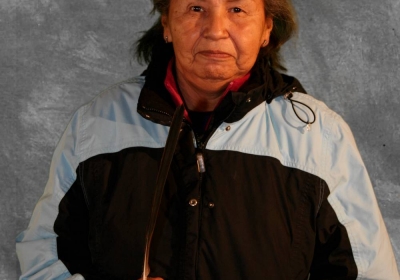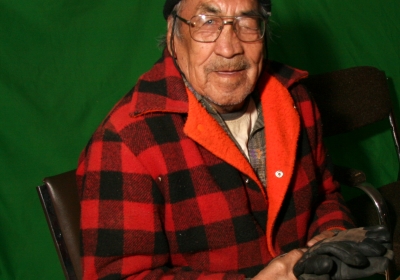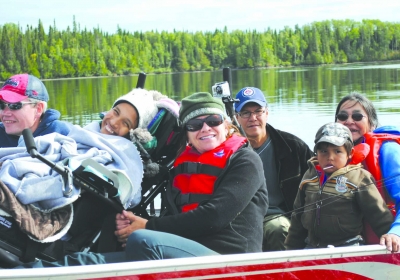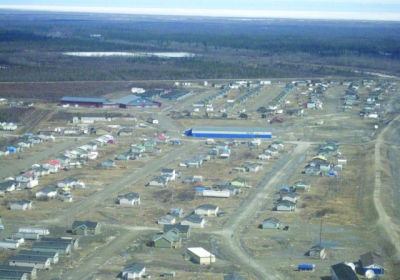I am the product, evolution of many thousands of years as are you.

Wawatay Staff
INAC spends $40,000 in Europe
Anishinabek Nation Deputy Grand Council Chief Glen Hare is wondering why Indian and Northern Affairs Canada spent more than $40,000 in Europe since 2006.
“They’re supposed to be representing our interests – we’re not aware of any First Nations in England,” Hare said. “We have plenty of funding problems in our own back yard. We don’t need INAC dollars spent in Europe.”
Elder Q&A: Rita Potson
Age: 68
Member of Seine River First Nation
Where were you born?
“In Seine River.”
How many children and grandchildren?
“Four kids, two girls, two boys and eight grandchildren.”
What jobs have you had?
“I worked in the tourist camp for 16 summers, brush-cutting, tree planting, trapping, pulp cutting, homemaker, mother and grandmother.”
What is the biggest change in the community?
Elder Q&A: Bob Kabatay
Age: 74
Member of Seine River First Nation
Where were you born?
“In Seine River, someplace close to here, on the trapline.”
How many children and grandchildren?
“Four sons, one daughter – maybe 100 grandchildren,. I don’t know, a lot.”
What jobs have you had?
“Cutting pulp, guiding, working in the sawmill, river drive, commercial fisherman and trapper.”
What is the biggest change in the community?
Indigenous film festival features films on Attawapiskat, Nibinamik youth
A documentary on an Attawapiskat youth’s push for equitable funding for education in First Nations communities will open the fifth annual Biindigaate Indigenous Film Festival Sept. 27-29 in Thunder Bay.
The film, called Hi-Ho Mistahey!, chronicles the youth-driven initiative called Shannen’s Dream to drive the federal government to make First Nations educational standards on par with the rest of Canada.
Canada must respect the right of indigenous peoples, say leaders
Indigenous Peoples’, human rights, and faith organizations are calling on Canada to ensure that indigenous peoples can freely decide for themselves whether and when resource development projects will take place on their traditional lands and territories.
In a statement released on the eve of the sixth anniversary of the adoption of the United Nations Declaration on the Rights of Indigenous Peoples, indigenous peoples’ and civil society organizations say it is time to end the colonial practice of imposing development decisions on indigenous peoples.
Year in Review: 2011 in Pictures
This week in Wawatay News...
ᐅᑭᑭᓄᐦᐊᒪᑫᐠ ᓂᑲᑌᐢᑲᐊᐧᐠ ᐃᒪ ᐱᑲᐣᒋᑲᒥᐣᐠ
ᒥᔑᐣ ᑲᑭᑭᓄᐦᐊᒪᑯᓯᐊᐧᐨ ᐃᒪ ᐱᑲᐣᒋᑲᒥᐣᐠ ᑲᐃᐧᐣ ᐊᐸᐣ ᒋᐃᐢᑯᓄᐊᐧᐨ ᐊᐱ 25 ᐅᑎᐢᑯᓂᐦᐃᐁᐧᐠ ᑲᑭ ᒪᒐᓂᐣᐨ ᐅᑕᔑᑫᐃᐧᓂᐊᐧ ᒥᓇᐊᐧ ᑲᑭᐱᒥᑯᓇᑲᓂᐠ.
ᐃᑫᐧᓂᐊᐧᐠ ᐅᑎᐢᑯᓂᐦᐃᐁᐧᐠ ᐅᑭ ᒪᒥᑎᓀᐣᑕᒧᐦᐃᑯᓇᐊᐧ ᒪᐊᐧᐨ ᒥᐢᑕᐦᐃ ᑲᐊᑲᐧᑯᔑᐊᐧᓂᐣᐠ ᑲᔑ ᑲᐯᔑᐧᐊᐨ.
ᑫᑲᐟ 700 ᑭᑭᓇᐦᐊᒪᐊᐧᑲᓇᐠ ᑲᐃᐧᐣ ᐊᐸᐣ ᒋᐅᐣᒋᔭᐊᐧᐨ ᑫᑕᔑ ᑭᑭᓄᐦᐊᒪᑯᓯᐊᐧᐨ, ᑲᔦ ᑲᑭᓇ ᐃᑫᐧᓂᐊᐧᐠ ᑲᐃᐢᐸᓂᐠ ᑭᑭᓄᐦᐊᒪᑫᐃᐧᓂᐣᐠ ᑲᑕᔑ ᐃᐢᑯᓄᐊᐧᐸᐣ. 17 ᐊᔭᐊᐧᐠ 12 ᑲᐊᑯᐢᑲᐊᐧᐨ ᐅᑎᐢᑯᓂᐣᐠ ᑲᑲᑫᐧ ᑭᔑᑐᐊᐧᐨ ᐅᑭᑭᓄᐦᐊᒪᑯᓯᐃᐧᓂᐊᐧ ᓄᑯᑦ ᑲᐊᐦᑭᐊᐧᐠ, ᒥᑕᐢ ᐊᐸᐣ ᐁᐃᔑᓇᑲᐧᐠ ᒋᐸᓂᓭᐊᐧᐨ ᐅᑭᑭᓄᐦᐊᑯᓯᐃᐧᓂᐊᐧ ᓄᑯᑦ ᑲᐊᐦᑭᐊᐧᐠ ᒥᓇ ᓇᐣᑕ ᑲᔦ ᐊᐸᐣ ᐁᑲ ᒋᑭ ᑭᔑᑐᐊᐧᐨ ᐅᑭᑭᓄᐦᐊᒪᑯᓯᐃᐧᓂᐊᐧ.
Inside Wawatay News this issue...
ᓂᓯᒋᐊᐧᓄᐠ ᓂᓂᒋᓇᑲᐧᐣ ᒋᒧᐡᑭᐱᐠ ᐊᓫᐸᓂ ᓯᐱ ᑭᐸᐦᐃᑲᓇᐣ
ᓂᐃᐧᐣ ᑲᐃᐧᐅᔑᒋᑲᑌᑭᐣ ᐊᓂᒥᑭ ᐃᐡᑯᑌ ᒋᐅᒋ ᐊᓄᑭᒪᑲᐠ ᑭᐸᑲᐧᐦᐃᑲᓇᐣ ᐃᒪ ᑲᐱᓇᑲᑲᒥ ᓯᐱᐠ ᐯᔓᐨ ᑲᐣᐢᑕᐣᐢ ᓴᑲᐦᐃᑲᓂᐠ ᐅᑐᒋ ᓇᓂᓴᓀᐣᑕᓇᐊᐧ ᑲᐅᒋᓂᓯᒋᐊᐧᐠ ᐃᒪ ᐊᓫᐸᓂ ᓯᐱᐠ ᑲᐊᔭᑭᐣ ᑕᔑᑫᐃᐧᓇᐣ.
ᐅᑭᒪᑲᓇᐠ ᐃᒪ ᐱᑕᐯᑯᐠ ᒥᓇ ᑭᔐᒋᐊᐧᓄᐠ ᐅᓂᓂᑌᑕᓇᐊᐧ ᒋᐅᒋ ᒪᒋᑐᒋᑫᒪᑲᓂᐠ ᑭᐡᐱᐣ ᐅᐣᒋ ᐃᐡᐱᐱᓭᓂᐠ, ᒋᒪᒋᑐᑕᑯᐊᐧᐨ ᑭᓄᔐᐠ ᒥᓇ ᐊᐃᐧᔭᔑᔕᐠ ᐁᑲᐧ ᒥᓇ ᒋᐅᒋ ᒪᒐᑲᒥᒋᑫᒪᑲᐠ ᐅᐣᒋᓂᓯᒋᐊᐧᐠ ᐃᒪ ᑭᐸᑲᐧᐦᐃᑲᓂᐠ.
“ᐊᔕ ᐣᑭᐱᓇᑭᐡᑲᒥᐣ ᐊᓂᐣ ᐁᐱᑌᐣᑕᑲᐧᑭᐣ ᐅᑕᓇᐠ ᑲᑭᐱᑕᓇᓄᑲᑌᑭᐣ ᐣᑕᑭᒥᓇᓂᐠ,” ᑭᐃᑭᑐ ᑭᔐᒋᐊᐧᐣ ᐅᑭᒪᑲᐣ ᒐᐧᓂᑕᐣ ᓴᐧᓫᐅᒪᐣ.
ᓇᐧᕑᐟᓫᐊᐣᐟ ᐸᐅᕑ ᑭᒋᐊᓄᑭᐃᐧᐣ ᐁᑲᐧ ᒥᓇ ᑲᐣᐢᑕᐣᑊ ᓴᑲᐦᐃᑲᐣ ᑭᓇᑯᒥᑐᐸᓂᐠ ᒋᐃᐧᑕᓄᑭᒥᑐᐊᐧᐨ ᒋᐅᔑᒋᑲᑌᑭᐣ ᓂᐃᐧᐣ ᑭᐸᑲᐧᐦᐃᑲᓇᐣ. ᐃᐁᐧ ᐯᔑᐠ ᒋᐅᐣᒋᒪᑲᐠ 6.5 ᒣᑲᐊᐧᐟᐢ ᐃᐡᑯᑌ ᐃᒪ ᒋᐅᒋ ᐊᓂᑯᐊᓄᑭᒪᑲᐠ ᐅᐣᑌᕑᐃᔪ ᐃᐡᑯᑌᐃᐧ ᐱᒥᐸᓂᒋᑲᐣ ᑲᐅᒋᐱᒥᐱᑌᐠ.
Ring of Fire court challenge dropped by Matawa in favour of negotiation
The Matawa First Nations are dropping a legal challenge and instead engaging in negotiation over Ring of Fire environmental assessments.
The communities announced this week that they will rely on negotiation and working with their hired negotiator Bob Rae instead of a judicial review of the Cliffs chromite project federal comprehensive study environmental assessment (EA) process.











I am the product, evolution of many thousands of years as are you. I grew up on the land in the remote far north of Ontario following in the footsteps of my...
One of the most beautiful serene places I’ve ever visited was on the banks of the Opinagau River in northern Ontario, just near the corner of land where...